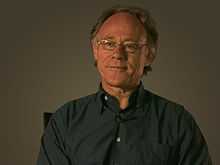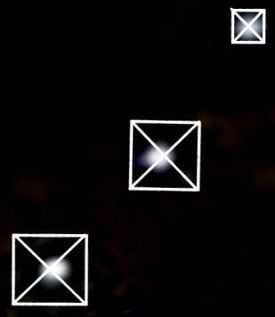Graham Hancock
| Graham Hancock | |
|---|---|
 | |
| Born |
August 2, 1950 Edinburgh, Scotland, UK |
| Nationality | British |
| Citizenship | British |
| Alma mater | Durham University |
| Occupation | Author |
| Known for | Author, The Sign and the Seal, Fingerprints of the Gods, The Message of the Sphinx, Entangled |
Graham Hancock (born 2 August 1950) is a British writer and journalist. Hancock specialises in unconventional theories[1] involving ancient civilizations, stone monuments or megaliths, altered states of consciousness, ancient myths and astronomical/astrological data from the past. One of the main themes running through many of his books is a posited global connection with a "mother culture" from which he believes all ancient historical civilizations sprang.[2]
Biography
Born in Edinburgh, Hancock's formative years were spent in India, where his father worked as a surgeon. Having returned to the UK, he graduated from Durham University in 1973, receiving a First Class Honours degree in sociology. As a journalist, Hancock worked for many British papers, such as The Times, The Sunday Times, The Independent, and The Guardian. He was co-editor of New Internationalist magazine from 1976–1979, and the East Africa correspondent of The Economist from 1981–1983.
Works
Hancock sees himself as a journalist who asks questions based upon observation and as someone who provides a counterbalance to what he perceives as the "unquestioned" acceptance and support given to orthodox views by the education system, the media, and by society at large.[3] Prior to 1990 his works dealt mainly with problems of economic and social development. Since 1990 his works have focused mainly on the possible connections between seemingly unrelated phenomena.
His books include Lords of Poverty, The Sign and the Seal, Fingerprints of the Gods, Keeper of Genesis (released in the US as Message of the Sphinx), The Mars Mystery, Heaven's Mirror (with wife Santha Faiia), Underworld: The Mysterious Origins of Civilization, and Talisman: Sacred Cities, Secret Faith (with co-author Robert Bauval). In 1996 he appeared in The Mysterious Origins of Man.[4] He also wrote and presented the documentaries Underworld: Flooded Kingdoms of the Ice Age (2002) and Quest for the Lost Civilisation (1998)[5] shown on Channel 4. In Hancock's book Talisman: Sacred Cities, Secret Faith,[6] co-authored with Robert Bauval, the two put forward "a version of the old Jewish-Masonic plot so beloved by ultra-right-wing conspiracy theorists."[7] They suggest a connection between the pillars of Solomon's Temple and the Twin Towers, and between the Star of David and The Pentagon.[8]
Hancock's most recent non-fiction book, Supernatural: Meetings With the Ancient Teachers of Mankind, was published in the UK in October 2005 and in the US in 2006. In it, Hancock examines paleolithic cave art in the light of David Lewis-Williams' neuropsychological model, exploring its relation to the development of the fully modern human mind.
His first novel, Entangled: The Eater of Souls, the first in a fantasy series, was published in the UK in April 2010 and in the US in October 2010. The novel makes use of Hancock's prior research interests and as he has noted, "What was there to lose, I asked myself, when my critics already described my factual books as fiction?"
Although his books have sold more than five million copies worldwide and have been translated into twenty-seven languages, his methods and conclusions have found little support among academics, his work being labelled "pseudoarchaeology".[1][9][10]
Orion correlation theory

One of the many recurring themes in several of Hancock's works has been an exposition on the "Orion correlation theory" (or OCT),[11][12] first put forward by Belgian writer Robert Bauval and then further expounded in collaborative works with Hancock, as well as in their separate publications.
BBC Horizon controversy
BBC Two's Horizon TV series broadcast a programme, Atlantis Reborn, on 4 November 1999 that challenged the ideas presented by Hancock. It detailed one of Hancock's claims that the arrangement of an ancient temple complex was designed to mirror astronomical features and attempted to demonstrate that the same thing could be done with perhaps equal justification using famous landmarks in New York. It also alleged that Hancock had selectively moved or ignored the locations of some of the temples to fit his own theories (see below).[13]
Hancock claimed he was misrepresented by the programme, and he and Robert Bauval made complaints to the Broadcasting Standards Commission against the way Horizon had portrayed them and their work. Eight points were raised by Hancock, two by Bauval (one of which duplicated a complaint of Hancock's).[14] This included the complaint that:
The BSC dismissed all but one of the complaints. Overall, the BSC concluded that "the programme makers acted in good faith in their examination of the theories of Mr Hancock and Mr Bauval".[16] The complaint which was upheld was thatThe programme had created the impression that he [Hancock] was an intellectual fraudster who had put forward half baked theories and ideas in bad faith, and that he was incompetent to defend his own arguments. Adjudication: [The Commission] finds no unfairness to Mr Hancock in these matters.[15]
The programme unfairly omitted one of their arguments in rebuttal of a speaker who criticised the theory of a significant correlation between the Giza pyramids and the belt stars of the constellation Orion (the "correlation theory")which the Commission did find to be unfair. That speaker was the astronomer Edwin Krupp. Krupp argued that Bauval had fudged the maps of Orion and the Pyramids by placing them upside down in terms of stellar directionality in order to make the theory work.[17] The BBC was not obligated to do more than broadcast an apology for the single point of unfairness but made a decision to modify the Orion sequence to demonstrate that the overall argument of the film remained intact. In Atlantis Reborn Again shown on 14 December 2000, Hancock and Bauval provided slightly lengthier rebuttals to Krupp and argued that the ancient Egyptians had made the Pyramids correlate in the most obvious and intuitive manner with the three stars of Orion's Belt, that Orion could only be seen at the highest point in the sky by the Egyptians looking in a southward direction and a work of symbolic and religious art. A counter argument was provided on Atlantis Reborn Again to Bauval and Hancock's responses to Krupp's statements.
Cultural references
In 2009, Roland Emmerich released his blockbuster disaster movie 2012 citing Fingerprints of the Gods in the credits as an inspiration for the film,[18] stating: "I always wanted to do a biblical flood movie, but I never felt I had the hook. I first read about the Earth's Crust Displacement Theory in Graham Hancock's Fingerprints of the Gods." [19] Also in 2009, author Geoff Stray released his best-selling book Beyond 2012: Catastrophe or Awakening? in which he cites Graham Hancock as one of his inspirations and as a guidepost to point others to do their own investigation into the wonder of ancient societies.[20]
Books
- Hancock, Graham (1985). Ethiopia: The Challenge of Hunger. London: V. Gollancz. ISBN 0-575-03680-X.
- Hancock, Graham; Enver Carim (1986). AIDS: The Deadly Epidemic. London: V. Gollancz. ISBN 0-575-03837-3.
- Hancock, Graham (1989). Lords of Poverty: The Power, Prestige, and Corruption of the International Aid Business. Boston: Atlantic Monthly Press. ISBN 0-87113-253-2.
- Hancock, Graham (1992). The Sign and the Seal: The Quest for the Lost Ark of the Covenant. New York: Crown. ISBN 0-517-57813-1.
- Hancock, Graham (1995). Fingerprints of the Gods: The Evidence of Earth's Lost Civilization. New York: Crown Publishers. ISBN 0-517-59348-3.
- Hancock, Graham; Robert Bauval (1996). The Message of the Sphinx: A Quest for the Hidden Legacy of Mankind. New York: Crown Publishers. ISBN 0-517-70503-6. Published in the United Kingdom as Hancock, Graham; Robert Bauval (1996). Keeper of Genesis: A Quest for the Hidden Legacy of Mankind. London: Heinemann. ISBN 0-434-00302-6.
- Hancock, Graham (1998). The Mars Mystery: A Tale of the End of Two Worlds. London: Michael Joseph. ISBN 0-7181-4314-0.
- Hancock, Graham; Santha Faiia (1998). Heaven's Mirror: Quest for the Lost Civilization. New York: Crown Publishers. ISBN 0-517-70811-6.
- Hancock, Graham; Santha Faiia (2001). Fingerprints of the Gods: The Quest Continues (New Updated Edition). New York: Crown Century. ISBN 0-7126-7906-5.
- Hancock, Graham (2002). Underworld: The Mysterious Origins of Civilization. New York: Crown. ISBN 1-4000-4612-2.
- Hancock, Graham; Robert Bauval (2004). Talisman: Sacred Cities, Secret Faith. Tisbury: Element Books. ISBN 0-00-719036-0.
- Hancock, Graham (2005). Supernatural: Meeting with the Ancient Teachers of Mankind. London: Century. ISBN 1-84413-681-7.
- Hancock, Graham (2010). Entangled: The Eater of Souls. New York: The Disinformation Company. ISBN 978-1-934708-56-9.[21]
- Hancock, Graham (2013). War God: Nights of the Witch. Coronet. ISBN 978-1-444734-37-9.[22]
Videos
- Quest for the Lost Civilization - Acorn Media (1998)
- Atlantis Reborn Again - BBC Horizon (2000)
- Earth Pilgrims - Earth Pilgrims Inc. (2010)
- The war on consciousness - TEDx (2013)
See also
References
- ↑ 1.0 1.1 Brian Regal, Pseudoscience: A Critical Encyclopedia (Greenwood Publishing Group, 2009). ISBN 0-313-35507-X
- ↑ "...the belief of Hancock and other writers in a lost civilisation that passed its wisdom on to ancient Egypt or the Maya repeats the theme of Atlantis: the antediluvian world popularised by Ignatius Donnelly from 1882." Kevin Greene, Tom Moore, Archaeology: An Introduction, page 252 (Routledge, 2010 edition). ISBN 978-0-203-83597-5
- ↑ Graham Hancock's website
- ↑ Thomas, Dave (March 1996). "NBC's Origins Show". Committee for Skeptical Inquiry. Archived from the original on 2007-02-03. Retrieved 2007-02-19.
- ↑ http://www.imdb.com/title/tt0252165/
- ↑ London: Michael Joseph, 2004. ISBN 0-7181-4315-9
- ↑ Barrett, David V (2004-08-19). "Preformtalisman-Sacred Cities Secret Faith". The Independent.
- ↑ Thompson, Damian (2008-01-12). "How Da Vinci Code tapped pseudo-fact hunger". The Daily Telegraph.
- ↑ "Diagnosing Pseudoarchaeology" by Garrett G. Fagan, in Garrett G. Fagan (ed), Archaeological Fantasies: How Pseudoarchaeology Misrepresents The Past and Misleads the Public, pages 27–28 (Routledge, 2006 edition). ISBN 0-415-30592-6
- ↑ Kevin Greene, Tom Moore, Archaeology: An Introduction (Routledge, 2010 edition). ISBN 978-0-203-83597-5
- ↑ Graham Hancock, Santha Faiia.Heaven’s Mirror: Quest For The Lost Civilization (London: Michael Joseph, 1998). ISBN 071843329
- ↑ Glenn Kreisberg (editor), Lost Knowledge of the Ancients: A Graham Hancock Reader (Bear & Company, 2010). ISBN 978-1-59143-117-6
- ↑ BBC (2000). "Atlantis Reborn Again [programme synopsis]". Science & Nature: Horizon. British Broadcasting Corporation. Retrieved 2009-09-01.
- ↑ BBC (2000). "Horizon: Atlantis Reborn and the Broadcasting Standards Commission". Science & Nature: Horizon. British Broadcasting Corporation. Retrieved 2009-09-01.
- ↑ Broadcasting Standards Commission (2000). "Synopsis of adjudication: Horizon: Atlantis Reborn (November 4th 1999)" (reproduced at BBC Online). Science & Nature: Horizon. British Broadcasting Corporation. Retrieved 2009-09-01.
- ↑ Broadcasting Standards Commission (30 November 2000). "Fairness Complaints" (PDF online reproduction). The Bulletin (London: Broadcasting Standards Commission) 37: 1–3. Retrieved 2009-09-01.
- ↑ BBC (2000). "Atlantis Reborn Again [programme synopsis]". Science & Nature: Horizon. British Broadcasting Corporation. Retrieved 2009-09-01.
- ↑ "2012 (2009) – Credit List". chicagoscifi.com. Retrieved 2009-11-25.
- ↑ Jenkins, David (2009-11-16). Roland Emmerich's guide to disaster movies. Time Out. Retrieved 2009-11-25.
- ↑ Beyond 2012: Catastrophe or Awakening?: A Complete Guide to End-of-Time Predictions, Bear & Company; 2nd Printing edition (May 21, 2009), ISBN 1-59143-097-6
- ↑ The Big Idea: Graham Hancock
- ↑ http://www.amazon.co.uk/War-God-Graham-Hancock/dp/1444734377/ref=la_B004561L0S_1_1
External links
- Official website
- Broadcasting Standards Commission – Synopsis of adjudication. Horizon: Atlantis Reborn (November 4, 1999)
- Horizon: Atlantis Reborn and the Broadcasting Standards Commission The BBC's response to the Horizon programme debate.
- Brass, M., nd, An analysis of the quality of Graham Hancock's "science", The Antiquity of Man Web Site (through archive.org).
- Brass, M., 2002, Tracing Graham Hancock's Shifting Cataclysm, Skeptical Inquirer. vol. 26, no. 4: 45–49.
- Carroll, R. T., 2009, Atlantis, The Skeptic’s Dictionary website.
- Fagan, N., nd, An Answer to Graham Hancock and Analysis of Hancock's Position Statement on C-14 Dating, Papers, In the Hall of Ma’at website.
- Flemming, N., nd, Review of Flooded Kingdoms of the Ice Age, Papers, In the Hall of Ma’at website.